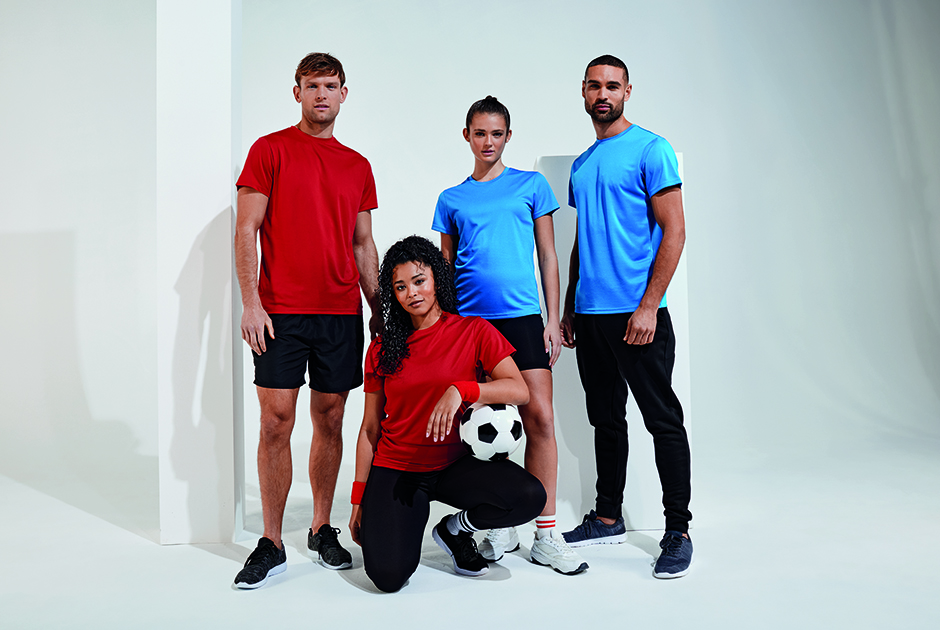Team sports are stronger than ever. At the same time, the continuing work-from-home culture has led to athletic wear that can transition from practice into life. “Athletes wanted comfortable, versatile gear that works beyond the game,” said Courtney Karam, director of marketing with Citadel Brands summing up the current situation.

Athletes today gravitate toward comfortable, versatile gear that works beyond the game, such as these Cool Tees. Photo courtesy of Citadel Brands
Another major trend is that sports and fashion, particularly fashion-forward streetwear, continue to merge, with Gen Z’ers and younger millennials having the most influence on fashion spilling over into sports. This has led to an oversized fit, as well as a shift toward unisex and gender- and size-inclusivity trends. Not only are unisex styles going trending but some companies like Royal Apparel are working on inclusive sizing, going up to size 5X in some cases.
“Unisex, oversized fits are dominating athleisure in 2025, blending comfort and style with a focus on relaxed silhouettes, neutral tones and versatile layering. This trend reflects the growing demand for gender-fluid fashion, emphasizing both function and streetwear- inspired aesthetics,” said Lauren Hoskinson, brand ambassador, TriDri Active.
As Gen Z and young millennials continue leading the way, they are also bringing back an old-school collegiate vibe while at the same time mixing it with modern streetwear and high-performance gear. “They want style, comfort, and a personal touch all in one,” said Rachel Hoskins, vice president of sales at Sock 101. She added that custom socks and sneakers are trending, with teams focused on style on top of performance. “From game day to streetwear, the vintage collegiate look is making a big comeback in both sportswear and retail. Think bold stripes, classic varsity fonts, and retro colorways—blending old-school vibes with modern performance.”
Besides the marriage of sports and fashion, unisex and oversized, some of the other buzzwords for this year’s athletic and teamwear market include versatility, comfort, moisture-wicking, sustainability, breathable and lightweight.
A Range of Influences
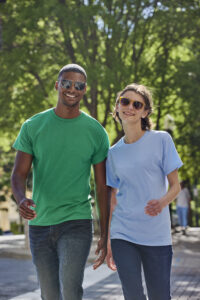
Rec leagues can be casual enough for participants to wear more classic athletic silhouettes, such as cotton tees. Photo courtesy of HanesBrands
Gen Z and the athletes and influencers that they follow are the primary drivers of trends in this space.
Most industry experts agree that fashion continues to play a major role in team sports, with amateur teams more closely emulating professional teams, yet another trend that is only growing each year. “Professional athletes are more visible due to social media, where the showcase their gameday attire as well as their training and lifestyle looks so it’s very easy for anyone to replicate what they see on these social platforms,” said Karam.
Glen Brumer, sales director with Royal Apparel agreed with the way these trends are coming from influencers and athletes, and what professional teams are wearing, noting that teams are reinventing the uniform as well as what is being worn to sporting events.
“Within this industry, you find trends drive demand, and brands keep the cycle going. Amateur teams follow professional styles for inspiration, team identity, brand influence and better performance wear,” Hoskinson added.
Boomers are influencing trends as well, as this demographic is concerned about health and mental well-being and is therefore participating in sports, like pickle ball, or joining walking or biking clubs. “Each of these activities could be organized to where they are all wearing high-performance team uniforms or could be casual enough for each participant to wear more classic athletic wear silhouettes, such as cotton tees and blended sweats,” said Marcus Davis, product development manager for HanesBrands.
Fit and Silhouettes
The pandemic solidified the place of athleisure in the market, with many people wearing casual, team-inspired clothing as part of their daily outfits. “As that became the norm in more formal settings, we’ve seen significant advancements in fabrics, innovations and products as consumer preferences shifted brands to move in that direction. There is a spectrum shift when you look at active use (uniforms) to passive use (daily wear/outfitting). As uniforms are getting tighter, slimmer, shorter and smaller, you’re seeing outfitting and daily worn apparel gets looser, more relaxed and oversized,” said Joel Bennink, senior vice-president of product for Momentec.
“For low-impact activities, looser or relaxed fits are popular for comfort and can provide warmth and layering opportunities, where high-impact activities may still rely on more fitted clothes for moisture wicking and stretch benefits, as they are closer to the body,” said Davis. “For off-field styling, classic tees, fleece crews and hoods are the go-to silhouettes in this space. The details on each remain simple with them not being over designed, such as hoodies being offered without drawcords. Relaxed fits are being requested more often for comfort and for layering opportunities.”
Karam agreed, saying: “Relaxed and oversize are making a comeback with a streetwear type of influence, with crossover designs of hoodies and joggers and layering pieces. Simple logos with muted tones are incorporated into the design. I do think women do have a more diverse range for fit, with baggy and oversized bottoms mixed with cropped and more fitting tops, while youth has a more fun and bold look.”
Fabrics, Materials
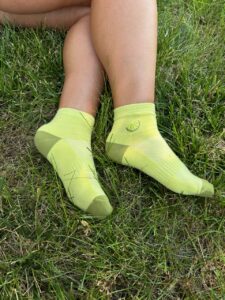
When it comes to socks and shoes, teams are looking to blend retro styles with modern touches. Photo courtesy of Sock 101
Polyester and polyester blends remain popular in this market segment, in part because of their being the best material for sublimation. That said, materials with some stretch are always welcome in the teamwear space. “Moisture wicking, anti-odor and UV protection are features that everyone will be asking for and expecting, but anything that has stretch and recovery for mobility and a soft hand for comfort will be a top seller,” said Davis.
Bennink added that while performance is still king in teamwear, he’d also still seeing a lot of movement toward softer fabrics, cotton handed synthetics, double knits and textures across the board.
“Fabrics can vary from 100-percent cotton, which remains popular due to the soft hand and breathability, to polyester/spandex blends, which can offer benefits such as wicking and stretch. Bottoms will remain important as long as the fabric and styling allow for diverse end-usage occasions, such as training, running and various sporting activities, while maintaining appeal as an everyday lifestyle item,” agreed Davis.
Recycled/alternative materials are also always being improved upon, with recycled polyester (rPET) becoming a staple, Hoskinson said, noting recycled fibers, and cationic dyed products are both trending. “Cationic dye means a product has a higher resistance to bleeding, staining and fading and can promise zero dye migration on to your chosen decoration technique,” Hoskinson said, explaining the advantages of the latter.
“The athletic orders we get have the best of both worlds: the comfort of cotton, and rPET gives you some of that performance,” said Brumer.
Patterns and Colors
Colors are all over the board this year. Brumer said to look for pops of bright, vivid colors trending as well as neutrals. Bright colors can be traced back to fashion influences, while neutrals are often influenced by nature.
“Team palettes don’t change, but how kids express themselves and get noticed through accessories—gloves, mouthguards, sleeves plus footwear continue to drive the trends. Textural patterns are also big—we’re seeing a range of tonal colors within those patterns, to really fun spectrums of cools (purples, turquoises/teals to light blues) or warms (orange to red to pink). Color combos are less abrasive on the eyes (neons), while still providing a pop to the overall look,” said Bennink.
Sustainability
The call for sustainability in apparel—in corporate practices as well as in actual materials used—continues to grow each year, with an increasing
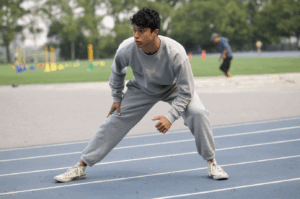
Unisex Fashion Fleece pulls double duty offering more than a trendy look. Photo courtesy of Royal Apparel
number of companies working to try to meet those customer demands. Still, not all experts see sustainability trending very heavily in the area of team apparel. “There are so many advancements in yarns, fabrics and processes that are happening right now. I wouldn’t say it’s at the very top of customers’ demands or wants yet in the team space though; it doesn’t drive the purchase amongst other key features and benefits necessarily,” said Bennink.
“Sustainability is becoming a larger focus for the majority of consumers, but comfort and performance adaptability will be what people look for in their active apparel,” agreed Davis.
One problem, he said, is the attention on the negative environmental impacts of microplastics, often found in recycled apparel. “Synthetic garments make up a large portion of what’s sold in the active wear and team wear markets, and these materials have a higher tendency to create microplastics as they typically do not biodegrade. There are many regulations and innovations being set in place to try and manage the impact of microplastics, from new standards for filters in washing machines to managing how we dispose of our clothes at the end of their lifecycle,” Davis said.
This awareness has led companies to work on innovative solutions and alternatives. Hanes, for example, introduced EcoSmart polyester technology into many of its products last year, which allows synthetic plastic-based fibers to behave more like natural fibers once they are in a landfill, unlike untreated polyester.
Customization Techniques
Customization remains key in athletic wear and team uniforms, though stock uniforms continue to sell well and will always likely have a place in the market.
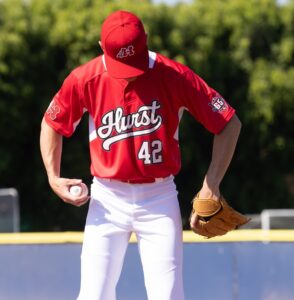
Customization remains dominant, but stock uniforms also have a strong presence. Photo courtesy of A4
“Customization is still a dominant force in athletic wear and team uniforms, but stock uniforms continue to have a strong market presence—especially for budget-conscious teams. However, the overall trend is shifting toward custom, performance-driven designs,” said Karam.
Brumer noted direct-to-film (DTF), in particular, has grown tremendously over the years. “You can do printing on demand; individual sport names or number lend itself to that,” he said, though if the team is all wearing the same thing, traditional screen-printing comes into play.
“With the continued growth of DTF printing, it’s easier to customize and decorate on just about any fabric blend now. Designers are no longer limited to sticking to high polyester content fabrics to support the decorating side of the business,” said Davis.
That said, sublimation remains important, particularly for polyester-dominant sportswear, which is why companies like Momentec invest heavily in it. “Sublimation is the biggest mover and shaker in the industry right now. It allows so much creativity and expression while allowing for speed and service needs at a reasonable cost,” said Bennink.
“I think embroidery is back in a big way, the consumer is appreciating the quality and the time it takes to get something custom embroidered,” said Hoskins, adding that heat transfer or sewn on patches are another way to personalize garments.
The Year Ahead
The future is bright for this segment of the market, due to the demand for versatility, comfort and performance.
“I still think it continues to be very, very strong. Real estate for activewear continues to grow. As society gets more and more casual, we don’t see it slowing down,” said Brumer.
“Team sports and activities will continue to grow as people look for community building and focus on their own mental and physical well-being. It’s not just organized team sports, but also activities that help build groups and communities that find a common interest in being active together. The products for each market can be completely different, so make sure to offer a variety to your customers, ranging from high tech polyester performance gear to cotton rich tees and sweats,” advised Davis.
“The athletic team wear market is expected to remain strong in 2025, driven by growing participation in sports, increased demand for customization, and advancements in sustainable and performance-driven materials. However, economic factors, supply chain challenges, and evolving consumer preferences will influence the pace of growth,” said Karam.
Hilary Daninhirsch is an award-winning freelance writer based in Pittsburgh. Her work has been featured in a number of lifestyle and trade magazines. She can be reached at [email protected] or hilarydaninhirsch.journoportfolio.com.

